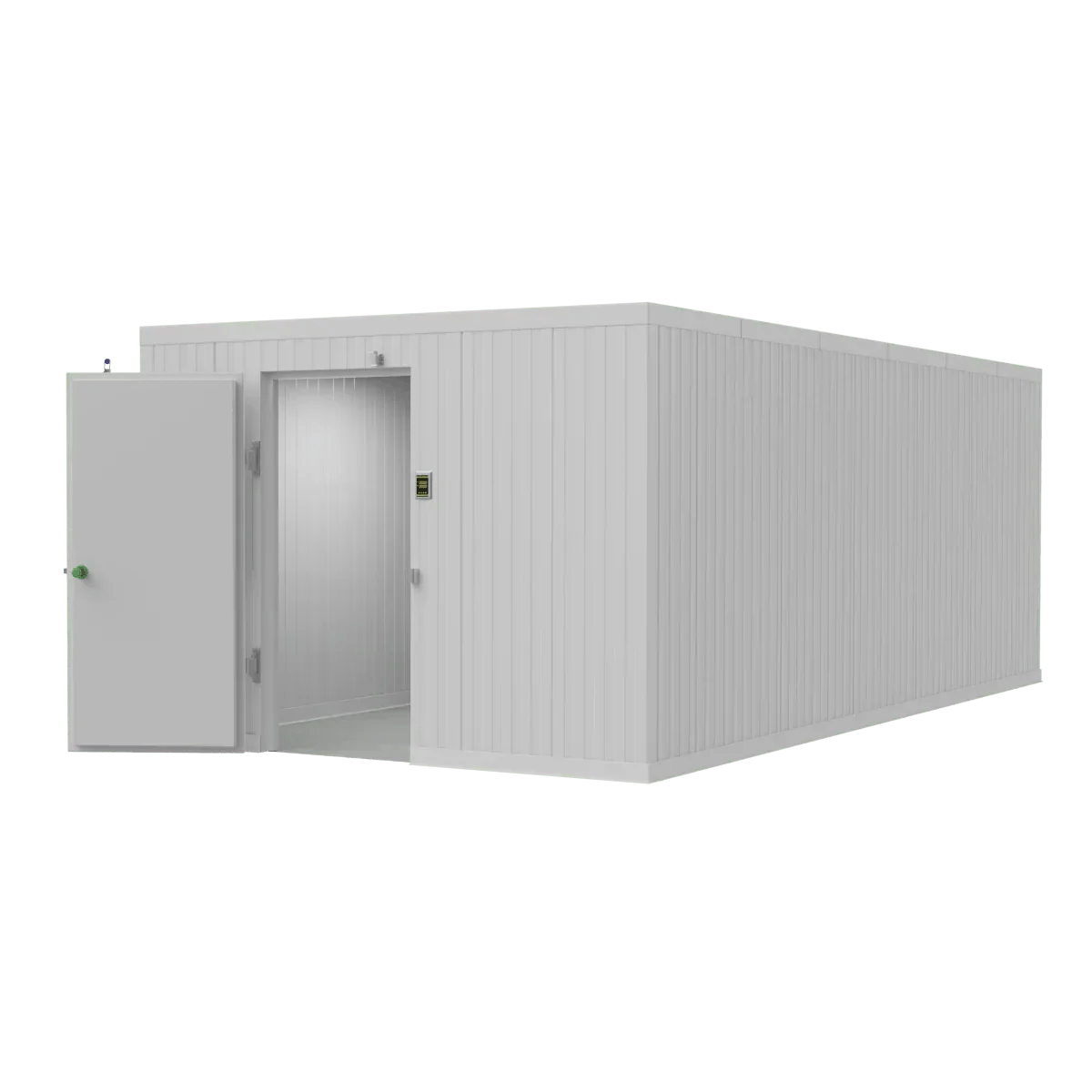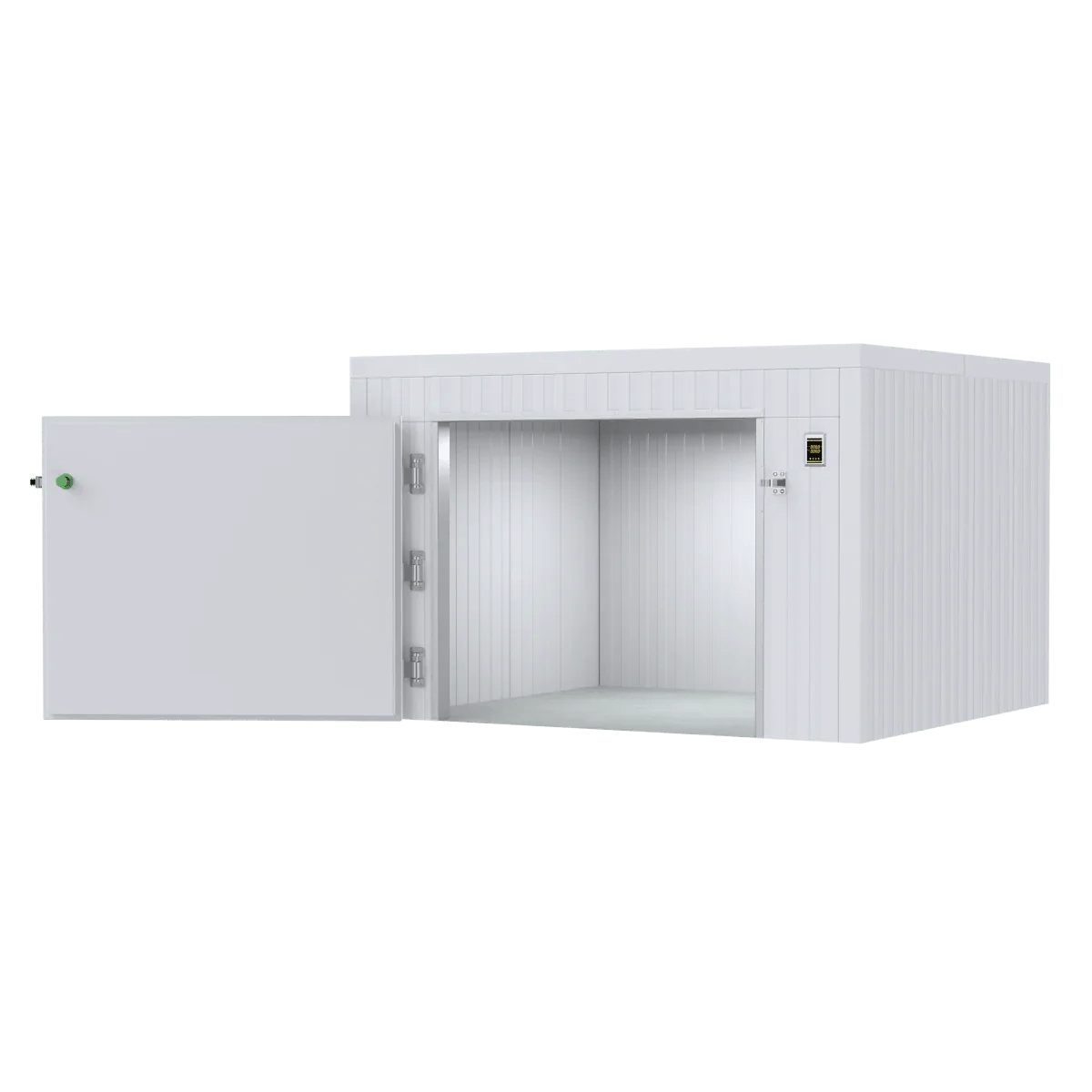Essential Equipment for Funeral Home Operations
Mortuary body lifts eliminate the risk of back injuries from manual lifting while allowing a single team member to handle remains safely. From basic hydraulic units to advanced electric scissor models, today’s funeral homes can find a lift that fits both their workflow and budget.
At-a-Glance Specs
- Load capacity: up to 1,000 lbs
- Materials: 304-grade stainless steel
- Options: manual, electric, track & gantry, stair climbers, winches
- Support: direct factory assistance and parts supply
I’m with American Mortuary Coolers, and we regularly help directors choose lifting equipment that integrates perfectly with our custom coolers and maximizes preparation-room efficiency.
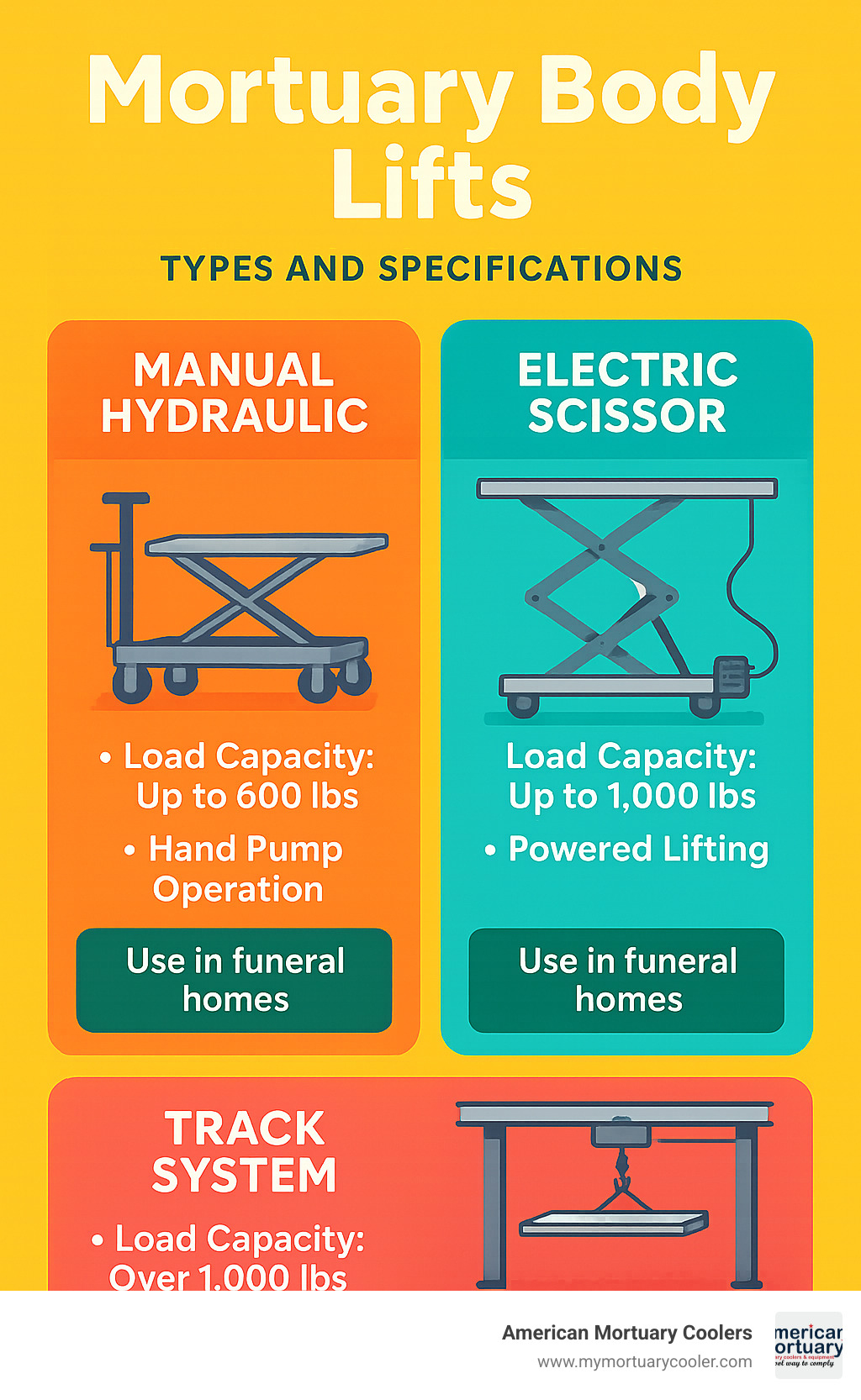
How Mortuary Body Lifts Serve the Funeral Industry
For more than half a century, purpose-built mortuary lifts such as the Ultimate 1000 Lift™ have quietly transformed preparation rooms. When a product remains a best-seller for decades, it speaks volumes about reliability.
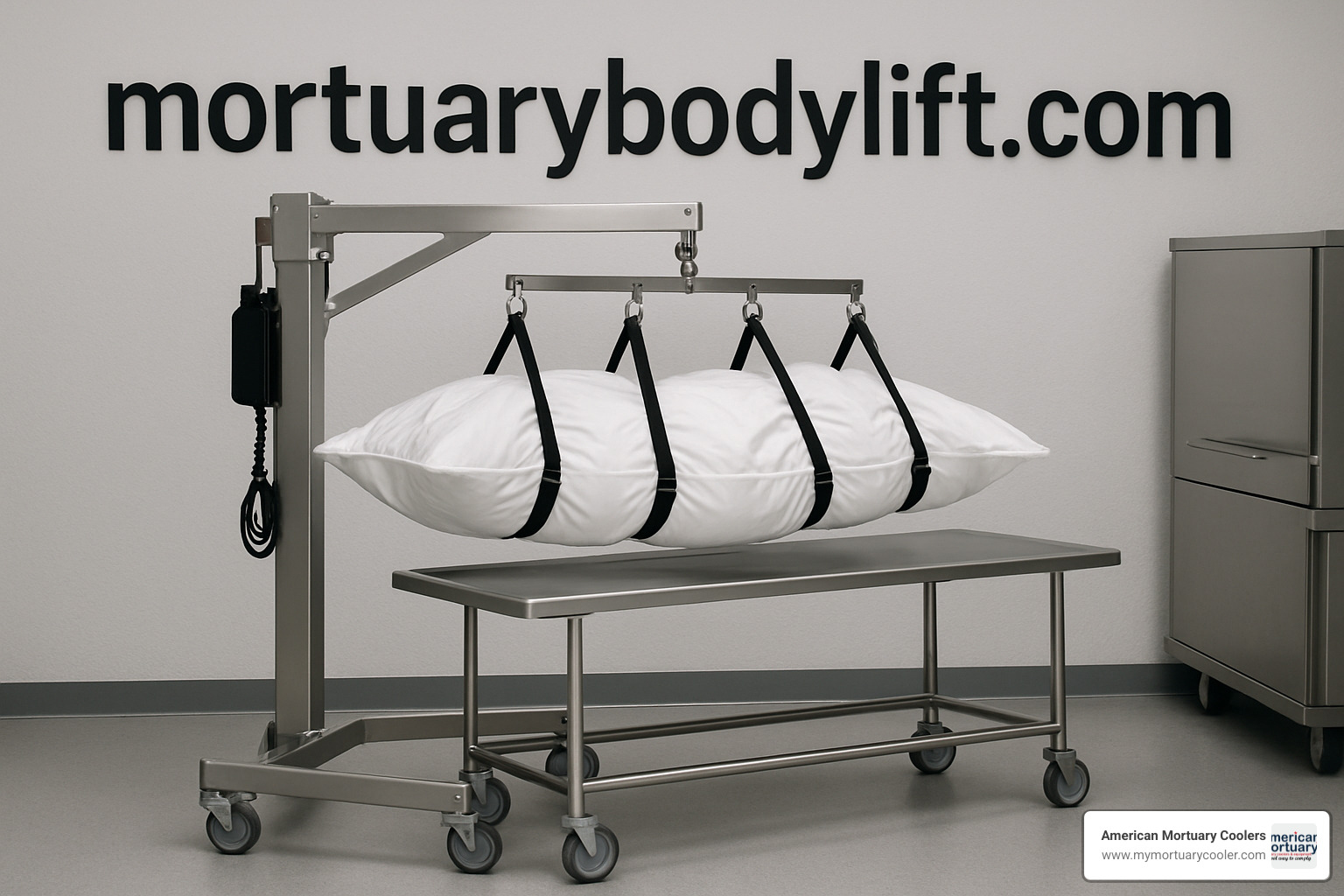
Unlike repurposed warehouse hoists, mortuary lifts are engineered specifically for body handling: quiet motors, smooth motion, and easy-to-sanitize finishes. Options now include electric stair climbers that act as a “second attendant” on removals and wireless winches for effortless vehicle loading.
Product Lines at a Glance
- Manual or electric floor lifts
- Single- and double-scissor tables
- Hydraulic trolleys
- Bariatric models rated to 1,000 lbs
- Overhead track & gantry systems
To see a detailed breakdown of the Ultimate 1000’s features, visit our comprehensive guide.
Why Buy Direct
Direct purchase means factory training, full warranty, quick access to parts, and the satisfaction of supporting American manufacturing. The same personal approach we use at American Mortuary Coolers applies here: expert advice matched to your unique layout and budget.
Types of Mortuary Body Lifts and Key Specifications
Choosing the right lift starts with understanding the major categories.
Manual Hydraulic Lifts
The Roundfin RD-1527—typical of this class—raises 440 lbs from 400 mm to 1,700 mm with simple pump action. Because no batteries are required, these lifts are popular as affordable, always-ready backups.
Powered Scissor Lifts
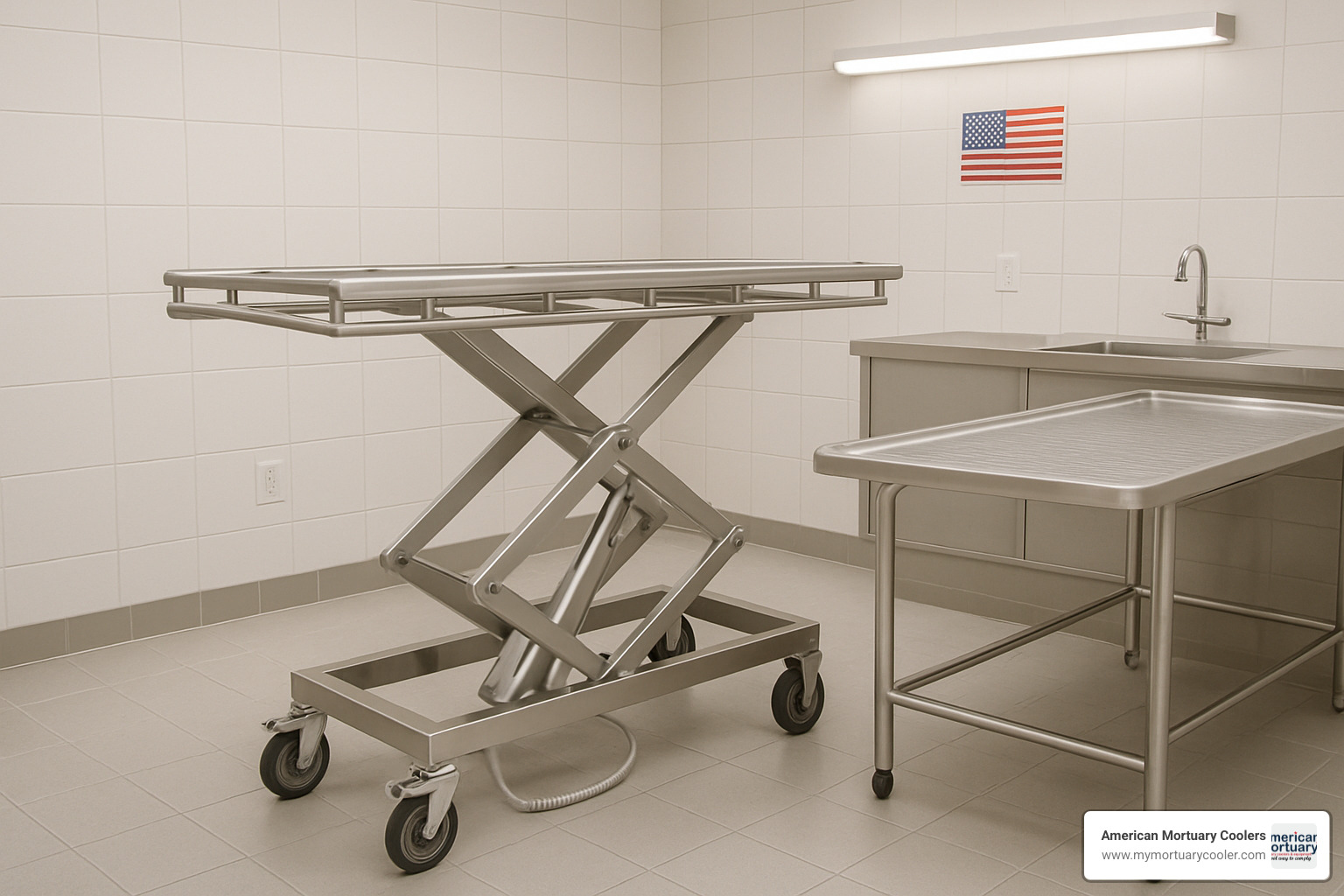
Electric scissor models raise 400-440 lbs to 1,500 mm (single) or 2,000 mm (double) at the push of a button. Lockable wheels, easy-clean trays and optional weighing scales make them the “Swiss-army knife” of prep-room handling.
Overhead Track & Gantry Systems
A ceiling-mounted track frees floor space and lets one operator glide remains from cooler to table without steering around obstacles. If you are planning new construction, include track support in the architectural drawings from day one.
Stair Climbers & Winches
Portable stair climbers (375 lbs capacity) turn night-time home removals into one-person jobs. Lightweight winches with wireless remotes pull caskets or stretchers (up to 1,000 lbs) into vehicles safely.
| Feature | Manual Hydraulic | Electric Scissor | Stair Climber | Winch |
|---|---|---|---|---|
| Power | Human | Battery/AC | Battery | Battery |
| Mobility | High | Medium | High | High |
| Height Range | 400–1700 mm | 420–2000 mm | Fixed | N/A |
| Capacity | 200 kg | 180–200 kg | 170 kg | 450 kg |
| Price* | $5.5–7 k | $8–12 k | $4.5–6.5 k | $3.5–5 k |
*Typical U.S. street pricing
Bariatric Solutions
With obesity rates climbing, bariatric lifts rated 1,000 lbs+ and equipped with 6-inch reinforced straps ensure dignity and safety for every family you serve.
For more details, read our complete guide to mortuary lift products.
Enhancing Safety & Efficiency with Modern Lifting Systems
Back injuries are among the most common workers-comp claims in funeral service. By transferring the heavy work to a lift, one staff member can:
- Remove from residences
- Steer stairs
- Load vehicles
- Transfer to prep tables or coolers
- Position bodies at ergonomically correct heights
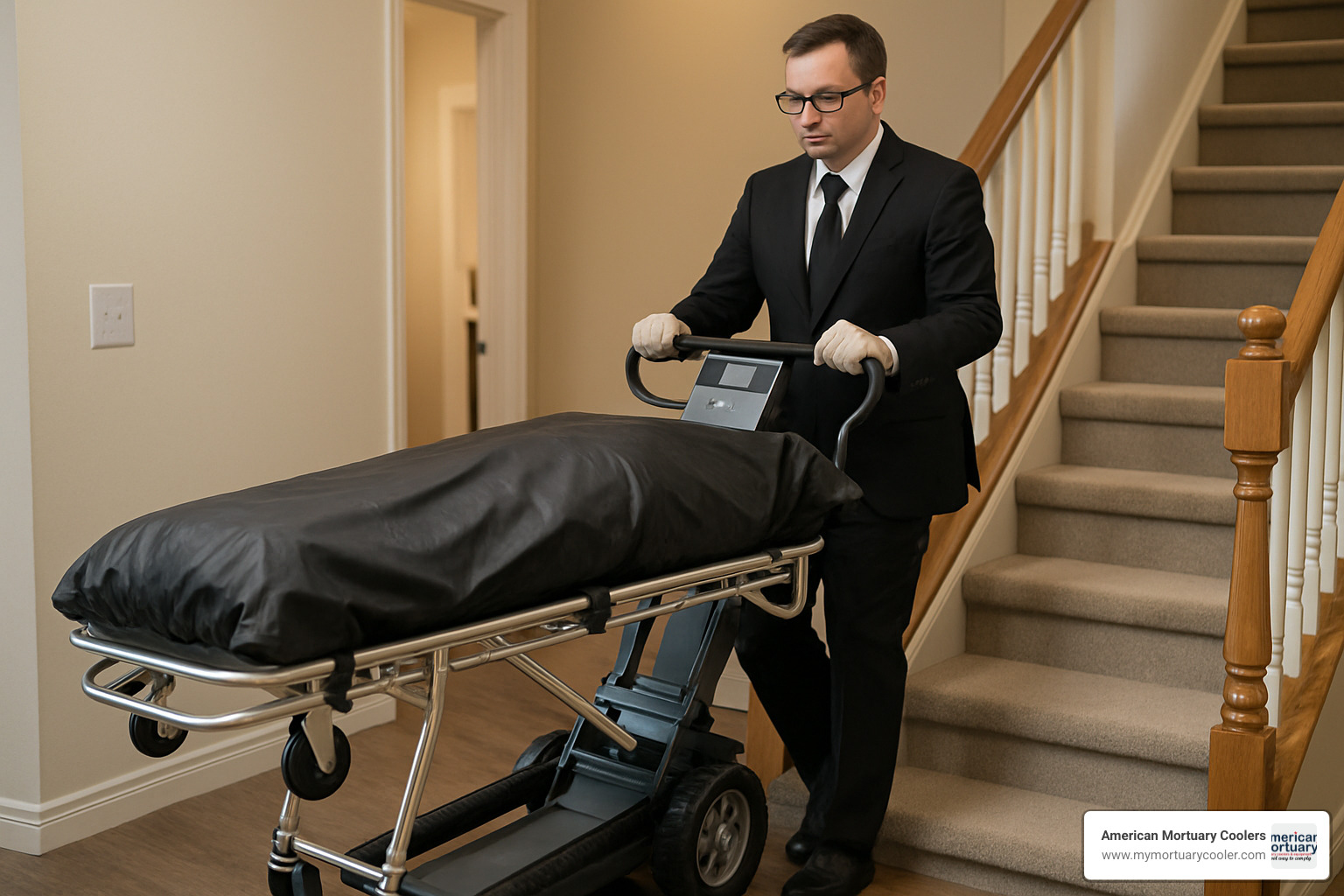
When integrated with our custom coolers, an overhead track can move remains directly from storage to the embalming table without lifting at all.
Must-Have Safety Features
- Emergency stop buttons
- Overload sensors
- Rated nylon straps (15′–25′)
- Pendant control sleeves
- CE / ISO certification
- Leak-proof hydraulic seals
These features protect both staff and the dignity of those in your care.
Buying Guide: Choosing the Right Lift, Accessories & Maintenance
Before ordering, measure doorways, ceiling heights and cooler positions, then consider community demographics. Facilities handling frequent bariatric cases or organ donations will need higher capacities and more positioning flexibility.
Accessories That Matter
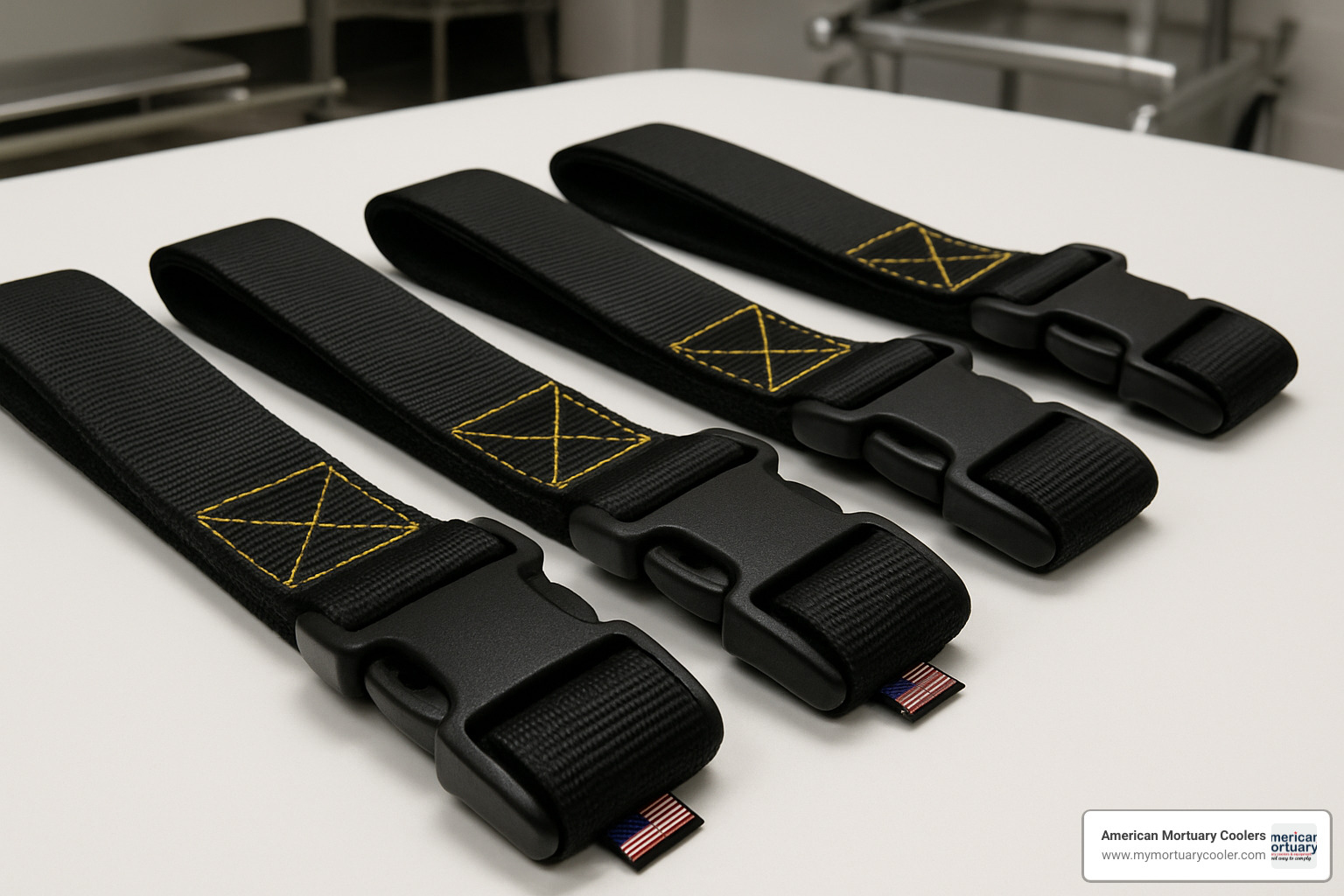
- 3-in and 6-in body straps
- Adjustable head slings
- Body Glide™ boards for lateral transfers
- Pendant safety sleeves
Having spare nylon straps and batteries on hand prevents downtime during busy periods.
Simple Maintenance Schedule
- Daily: wipe surfaces, check strap condition, top-off batteries
- Monthly: test emergency stops, lubricate casters, inspect fluid levels
- Yearly: professional load test and full electrical inspection
Consistent care extends equipment life and protects staff.
Frequently Asked Questions about Mortuary Body Lift Equipment
What is the typical weight limit and height range?
When funeral directors ask me about mortuary lifts, weight capacity is usually their first concern. The standard models comfortably handle 180-200 kg (about 400-440 lbs), which covers most everyday situations in funeral homes across Tennessee to California.
For facilities regularly serving larger individuals, specialized bariatric models are true workhorses, supporting up to 450 kg (1,000 lbs) or more. This extra capacity provides peace of mind when handling heavier cases.
Height adjustment is equally important for proper ergonomics. Single scissor models give you a working range from 400-1500 mm, while the double scissor versions extend further to 2000 mm – perfect for taller staff members who need higher working positions to prevent back strain.
The standard body trays measure approximately 2200 × 650 mm, providing ample space for secure positioning. Just remember, even with high-capacity equipment, proper weight distribution and correct strap placement remain crucial for safe operation. I've seen even the best equipment used incorrectly, which defeats its purpose entirely.
How do electric lifts compare to stretchers and cots?
I often explain to funeral homes that electric lifts and traditional stretchers serve different but complementary roles – like having both a pickup truck and a sedan in your garage.
Electric lifts excel at vertical movement. They're your preparation room workhorses, designed to raise and lower bodies with push-button ease, positioning them at the perfect working height. While they typically have limited mobility once loaded, their primary purpose is reducing the physical strain of lifting. Yes, they require a higher initial investment, but many funeral directors tell me the long-term benefits for staff health make them worthwhile, especially when integrated into your overall preparation room workflow.
Stretchers and cots, meanwhile, shine in horizontal transport. They're built for mobility, making them ideal for removals and transfers between locations. While they're generally more affordable upfront, they often require multiple staff members for safe operation, especially on stairs or with heavier cases. Most offer limited height adjustment compared to dedicated lift systems.
In my experience working with funeral homes from Johnson City to Los Angeles, the most efficient operations typically invest in both: quality electric lifts for their preparation rooms and reliable stretchers for removal services. This combination provides complete coverage for all body handling needs while maximizing staff safety.
What training and support are typically included with purchase?
Quality manufacturers typically provide comprehensive support with their mortuary lift equipment.
When you purchase directly from them, you'll receive practical, hands-on operational training for everyone who'll be using the equipment. This isn't just a quick walkthrough; they ensure your team genuinely understands how to operate everything safely and efficiently.
Installation guidance is equally thorough, with technical support available to ensure proper mounting and setup. This is particularly valuable for ceiling track systems or wall-mounted units where proper installation is critical for safety.
Every purchase should include comprehensive documentation covering operation, maintenance, and troubleshooting. These manuals are surprisingly readable – not the confusing technical jargon you might expect.
Perhaps most valuable is direct phone support. Having a real person to talk you through issues can be a lifesaver, especially during busy periods when equipment downtime isn't an option.
Reputable companies also maintain excellent availability of replacement parts through their catalogs, which means you won't be left with unusable equipment waiting for some obscure component. At American Mortuary Coolers, we've found this level of support matches our own approach to customer service – being there for the long haul, not just during the initial sale.
Conclusion & Next Steps
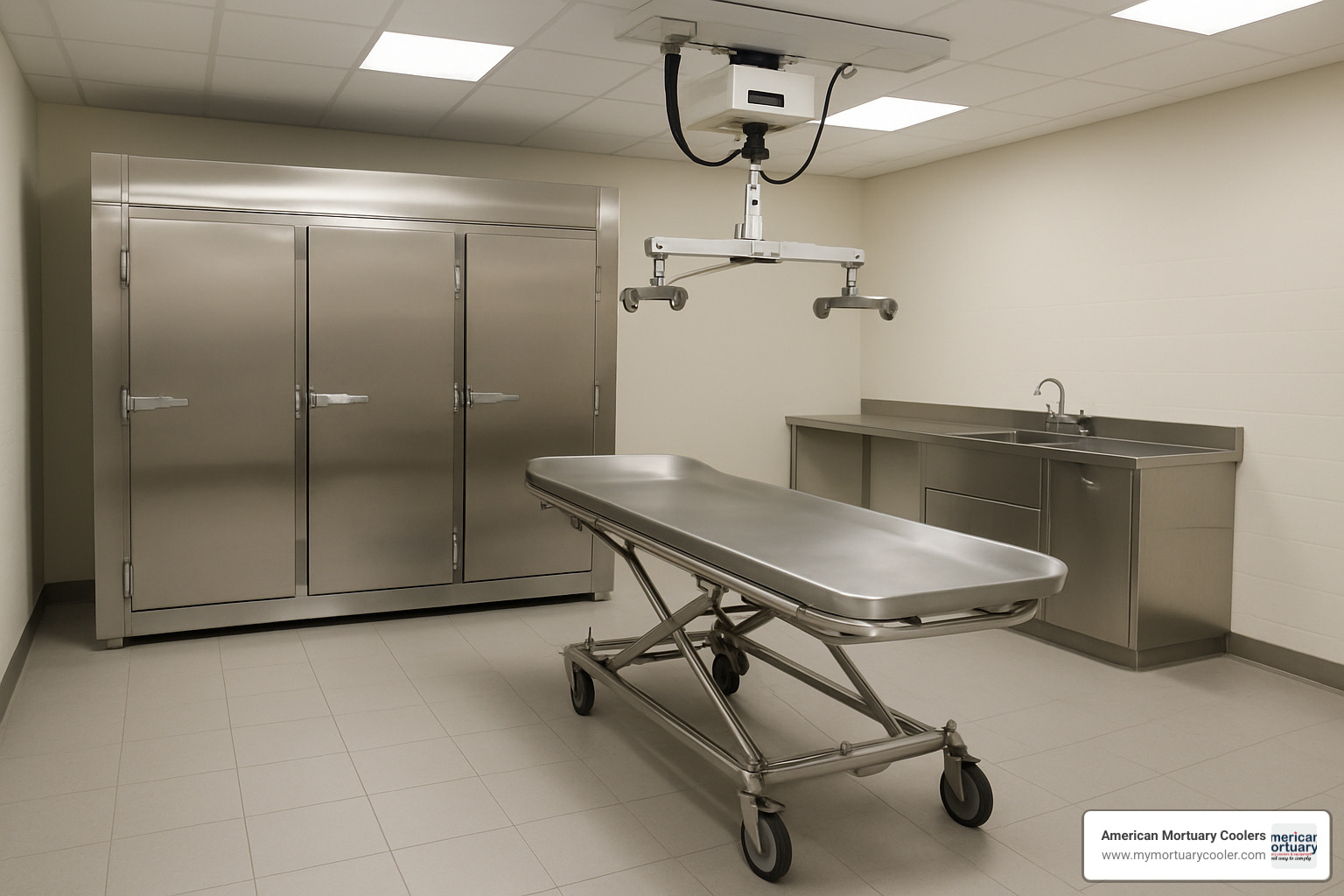
Quality mortuary lifts and custom coolers create a workflow that protects employees and honors families. Take a walk through your prep room and note every time staff lift, twist or strain. Each of those moments can be corrected with the right equipment.
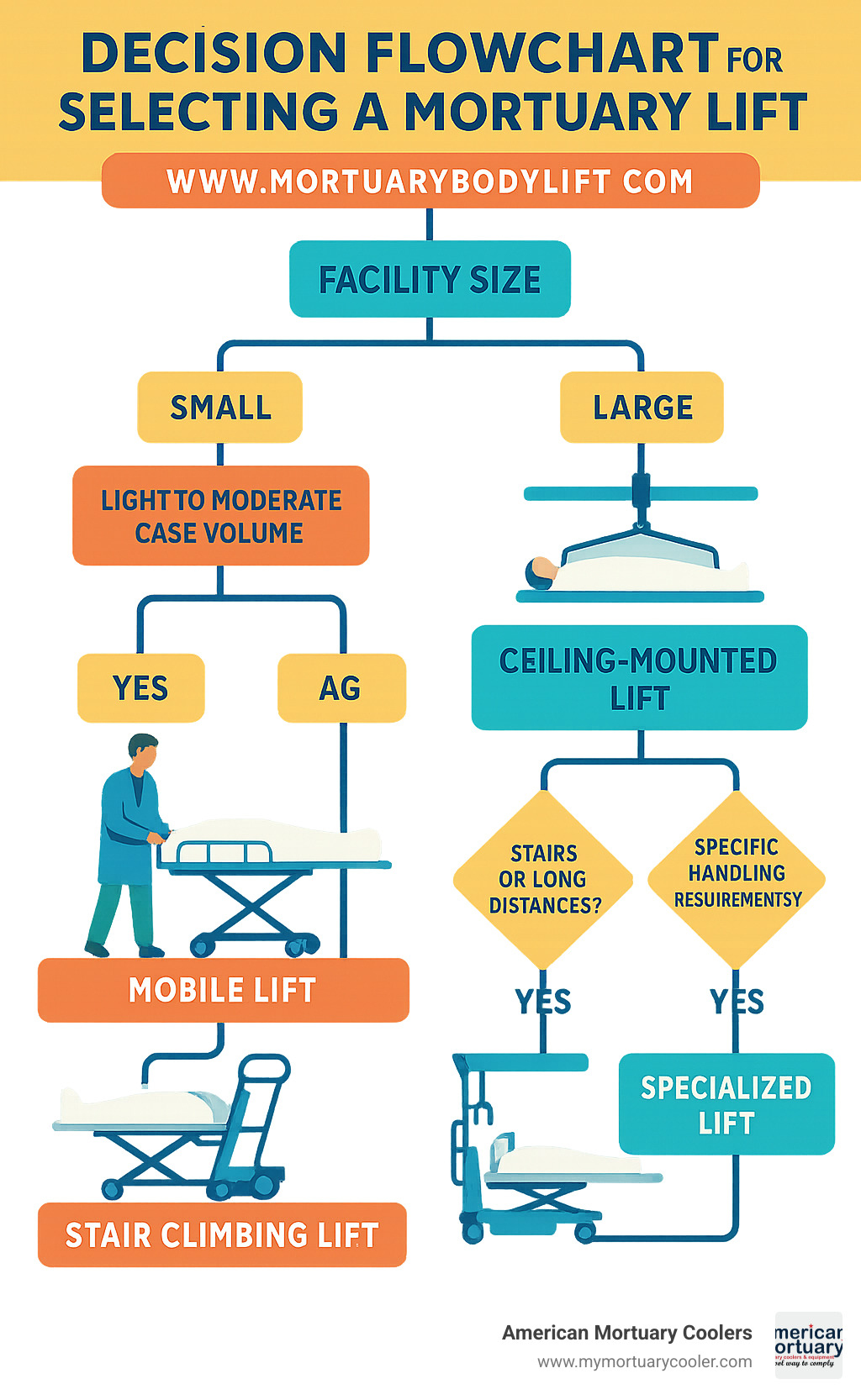
Ready to upgrade? Explore our resources on mortuary coolers or call American Mortuary Coolers at 1-800-248-8912 for a personalized consultation.

















